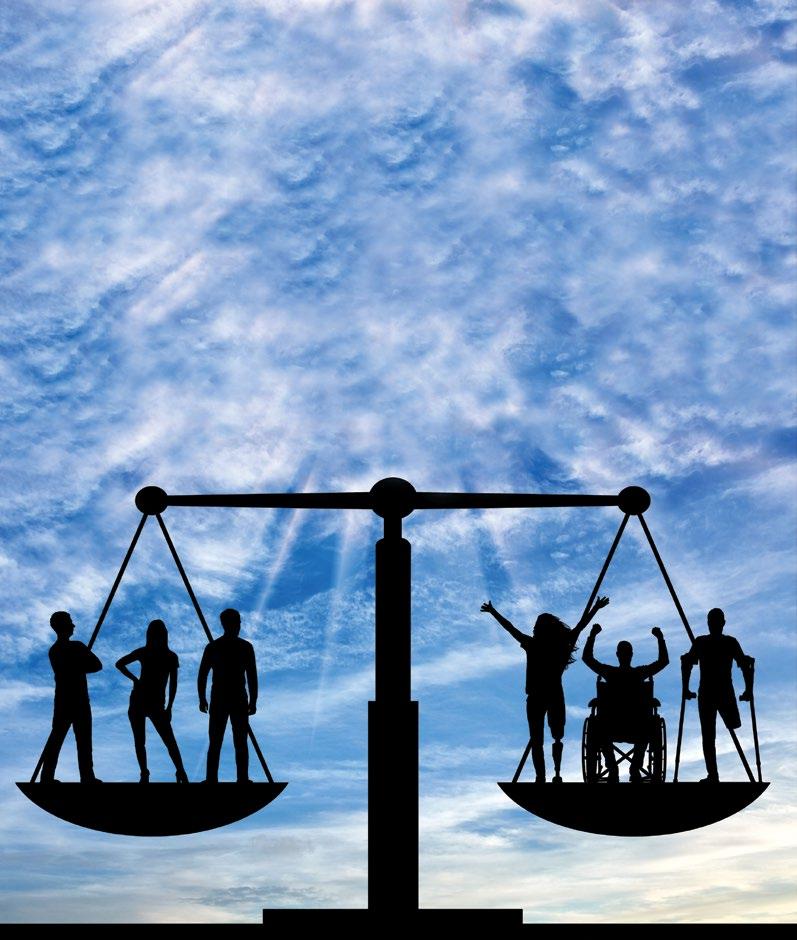
6 minute read
Employee induction a vital step for productivity & job satisfaction for people with disabilities
Employee induction a vital step for productivity &
job satisfaction for people with disabilities
South Africa’s progressive employment equity legislation has not gone far enough to enable people with disabilities to fully integrate into workplaces and perform their jobs optimally.

In a recent study co-published by Dr Armand Bam, Head of Social Impact at the University of Stellenbosch Business School (USB), it was found that South African businesses are failing to meet regulatory targets for the employment of people with disabilities, while disillusionment with workplaces that do not accommodate their physical, social and professional needs contributes to the growing unemployment and underemployment of disabled people.
“Rather than focusing on legislative compliance and regulatory targets, employers need to re-think how they define inclusion and provide an enabling working environment that supports disabled people’s integration and productivity from day one,” says Dr Bam.
“If employers and managers improve their people management processes around recruitment, hiring and induction of people with disabilities, and develop an inclusive organisational culture rather than simply focusing on legal compliance, they are in turn more likely to meet their employment equity targets,” he adds.
Dr Bam, together with Prof Linda Ronnie of the UCT Graduate School of Business, researched disabled employees’ experiences of inclusion, from recruitment to orientation and their first six months
on the job.[i] They aimed to better understand the challenges that hinder disabled people’s economic participation and caused many to abandon formal employment altogether.
Employee induction and orientation sets the tone for the employer-employee relationship, relationships with co-workers, and the nature of the working environment.
For people with disabilities, this initial experience influences their sense of acceptance and integration in the workplace, as well as productivity and job satisfaction.
Disabled people want seamless integration
Dr Bam’s research showed that what disabled people want most is “seamless integration” and to be actively involved in decision-making about how their disability is disclosed to co-workers and how their induction into the organisation is managed.
“They want to be able to slot in beside their coworkers without fanfare or special processes. Their ability to do this is dependent on an organisational culture of acceptance rather than focusing on differences and narrow definitions of ‘normal’.
“It is also crucial that people with disabilities are able to decide for themselves about disclosure of their disability, and that they are able to provide their first-hand input in orientation processes, rather than having experts give ‘disability awareness’ talks to their co-workers,” he said.
Dr Bam also cautioned that when people with disabilities feel pressure to appear 'normal' in order to be accepted, they often strive to exceed expectations of their abilities. In addition to fatigue, frustration and lack of job satisfaction, they also potentially place themselves at risk when they try to “exert themselves beyond their physical capacity” or perform in the same way that people without disabilities can.
“With rising unemployment in South Africa and employment rates of disabled people declining, off an already low base, we need practical strategies to achieve meaningful inclusion in the workplace and economic participation in society. This is all the more relevant for people with disabilities, whose unique needs are too often overshadowed by the structural problems affecting employment and economic empowerment that impact the majority.
Employers often confuse equality with equity
“If South Africa is to build a truly inclusive society, people with disabilities must take their rightful place in the mainstream of the economy,” Dr
Bam says. "Employers often confuse equality with equity”.
“Prioritising equality by mistakenly attempting to treat people with disabilities ‘like everyone else’ might be well-intentioned, but it fails to achieve equity.
“Equity means recognising that all people have different circumstances and needs, accommodating the unique challenges of people with disabilities, and allocating the support and resources that enables them to succeed.”
Recommendations
Based on the findings of the research, Dr Bam offers a number of recommendations for employers and managers to promote better employment experiences for people with disabilities, with the aim of achieving a more diverse workforce and truly inclusive organisations including: • the appointment of a disability champion to promote and account for disability equity within the organisation; • the development of more inclusive recruitment and orientation practices, enlisting co-workers for support; and • the active involvement of people with disabilities in shaping onboarding processes.
A disability champion should be drawn from top management, says Dr Bam, “to overcome some of the broad challenges related to organisations not understanding or being attuned to the needs of people with disabilities”.
The disability champion would develop an understanding of the 'disability landscape' within the business and develop employment strategies and policies to recruit, place, and retain disabled employees.
Dr Bam says that managers, responsible for employment of people, were critical to the work experiences of people with disabilities. As managers play a key role in organisational cohesion, developing their understanding of the needs of people with disabilities would contribute to a sense of community and inclusive organisational culture.
Further practical steps Dr Bam recommends include:
Induction and orientation: Preparing for the arrival of employees with disabilities even prior to induction day is the first step to inclusivity. Employers are advised to consult with the new employee and have necessary alterations to the physical environment or provision of assistive technology in place before their first day at work.
“Managers who engage earlier with people with disabilities to understand their needs before arrival contribute to them being confident employees and improve their chances of integration into the organisation,” Dr Bam says.
Disabled employees who participated in the research were uncomfortable with structured, generic 'disability awareness or sensitisation' programmes, feeling these were more aimed at allaying the concerns of non-disabled employees than addressing issues faced by people with disabilities.
Dr Bam recommends that people with disabilities be given the space to share their own experiences and needs first-hand during induction
programmes. Disclosure: Having control over the way their
disability is disclosed allows people with disabilities to directly address any fears or stereotypes held by their co-workers.
In contrast, Dr Bam says, people with disabilities experience a sense of betrayal and disempowerment when their disability is disclosed to others without their consent. Support from co-workers: While people with disabilities prefer to 'blend in' to a new work environment and the existing ways of doing things, some might also need assistance from coworkers.
Assigning a mentor or using a 'buddy system' could be helpful, Dr Bam says, but the new employee’s manager also needs to be available during the induction period to provide reassurance and an opportunity for the employee to raise any concerns about accommodation of their specific needs.
The research participants experienced “high levels of anxiety and frustration when managers were unavailable during their orientation”, he adds.
“This created unnecessary tension between disabled employees and their co-workers who did not know how best to assist them.”
Dr Bam says that managers need to balance the needs of the disabled person with ensuring that an employee assigned to assist is properly equipped to do so.
“There is sensitivity and acceptance needed on both sides when a disabled person is reliant on others to facilitate their inclusion and so has to discuss their personal needs with a relative stranger.”
Lastly, Dr Bam stresses that employees with disabilities who participated in the study wanted to “be accepted on their own terms by fellow employees and managers and be seen as individuals in their own right”.

All information and recommendations in this article are drawn from Dr Bam and Prof Ronnie’s findings, published as:
Bam A & Ronnie L. Inclusion at the Workplace: An Exploratory Study of People with Disabilities in South Africa. International Journal of Disability Management, Vol 15, 2020, e6. https://www.cambridge.org/core/journals/international-journal-of-
disability-management/article/abs/inclusion-at-the-workplace-an-exploratory-study-of-people-with-disabilities-in-south-africa/D60BCC316578054E3E1605222C465883#










